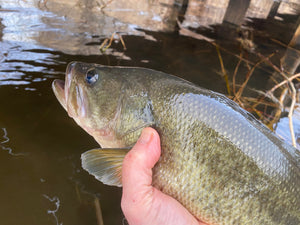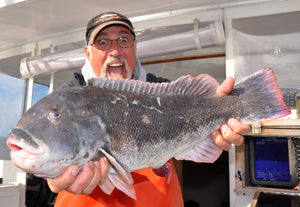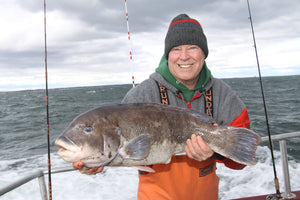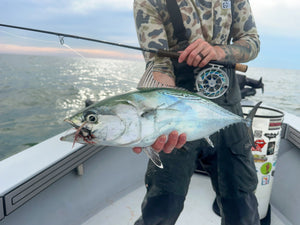Fall Season Wreck Fishing

Black sea bass and scup usually guarantee you’ll return with some fillets on near-shore wreck trips during the fall. This one fell for a Spro Bucktail. OutdoorTom.com photo.
Mixed-bag near-shore wreck trips in September and October, be they on a private vessel, six-pack charter or open boat, offer Long Island anglers an opportunity to stock-up on fillets of their favorite bottom species during the early fall before the weather begins to really chill down and the action moves further off the beach sometime in November.
While these trips have been popular for years the past decade has really seen them gain in popularity, not only because they are productive and fun, but also because they are so straight-forward when it comes to choosing your tackle, rigging and bait for the pleasant mix of knob-headed black sea bass, bulldog blackfish, dinner-sized scup, triggerfish, ling, and occasional codfish you’ll be hoping to catch.
So, let’s start with the basics and try to keep this all nice and simple. In the fishing rod department, you’ll want to go with something along the lines of a 6-foot, 6-inch, Shimano Teramar Northeast medium-heavy model, which should be absolutely perfect for getting your baits down to the bottom and cranking up whatever you manage to stick. Match this to a size 20 or 30 Daiwa Saltist LW conventional reel or size 20 Daiwa Saltist Star Drag, spooled with 30-pound-test Power Pro Super Slick V2 braided line and you should be able to handle anything you hook on these trips with little difficulty.
In terms of rigging, keep that simple, too. Tie on a White Water Custom Sea Bass Rig with size 2/0-4/0 hooks, or a Jigging World Single-Hook Blackfish Rig if your think the white chins will be in play. Anchor your selected rig with a 6 – 10-ounce sinker based on water depth and current strength, and you are set to go.
 Codfish are a welcome treat on the near-shore wreck scene. Although most anglers look for them on deeper offshore wrecks, they can occasionally surprise those working small, isolated pieces of structure. This one was caught just two miles off the beach. Outdoor Tom photo.
Codfish are a welcome treat on the near-shore wreck scene. Although most anglers look for them on deeper offshore wrecks, they can occasionally surprise those working small, isolated pieces of structure. This one was caught just two miles off the beach. Outdoor Tom photo.
In terms of baiting-up, skimmer clam and squid strips are the usual offerings, but bring along some green crabs if blackfish get you pumped. Be sure to pay attention to which baits seem to be working best, and don’t be afraid to switch from one to another – or back again – as the action dictates.
Most days, the clam baits carry great favor with the scup, sea bass, triggers and ling. Hook each piece just once through the tough “tongue” section making sure the entire barb protrudes slightly from the meat. A single piece of skimmer clam will usually produce better than several pieces strung together on the hook as it will be easier for your quarry to swallow and should appear more natural in the water. Poke through your bait bucket to find clam pieces that have a stringy filament of flesh you can leave trailing from the hook’s bend. The added motion that piece will have as it flutters in the current can really make a difference in the quality of your catch over the course of a day - especially when the bigger sea bass seem to be a bit shy. Be aware also that blackfish are happy to take clams, too, but the tasty togs do prefer crabs when given a choice.
 You never know what you’ll get on a fall wreck trip. This pollack was taken by Jeremy Wade of River Monsters TV a while back on a relatively short run. OutdoorTom.com photo.
You never know what you’ll get on a fall wreck trip. This pollack was taken by Jeremy Wade of River Monsters TV a while back on a relatively short run. OutdoorTom.com photo.
In terms of other tips that can help get you off to a solid start, one is to not rush when dropping your line in the water after the boat has stopped. Instead, allow a minute or two to pass so that everyone gets their line set on the bottom, then use an underhand flip to toss your line straight out ten or twenty yards from the boat. This will allow your line to settle just outside the edge of everyone else’s baits where it can easily stand out.
Holding out for lunker bites is another option. It may mean you’ll lose a lot of baits during the day, but it often results in adding a bulldog blackfish, knob-headed sea bass or even a stray cod or pollack to the cooler.
Lastly, keep in mind that lunkers or all sorts of bottom species generally inhale baits with a more deliberate, stronger tug than their smaller brethren. If you can resist the temptation to set the hook on the first few light taps of smaller fish, the chances of bigger fish getting to your baits are likely to increase. At that point, it’s all up to you to bring ‘em aboard.
- Bryce Poyer






